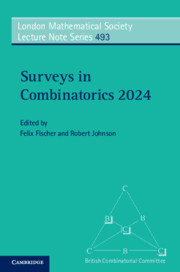Book contents
- Frontmatter
- Contents
- Preface
- Intersection Theory of Matroids: Variations on a Theme
- Erdős Covering Systems
- The Cluster Expansion in Combinatorics
- Sublinear Expanders and Their Applications
- Transversals in Latin Squares
- Finite Field Models in Arithmetic Combinatorics – Twenty Years On
- The Slice Rank Polynomial Method – A Survey a Few Years Later
- An Introduction to Transshipments Over Time
- Oriented Trees and Paths in Digraphs
- References
The Slice Rank Polynomial Method – A Survey a Few Years Later
Published online by Cambridge University Press: 23 May 2024
- Frontmatter
- Contents
- Preface
- Intersection Theory of Matroids: Variations on a Theme
- Erdős Covering Systems
- The Cluster Expansion in Combinatorics
- Sublinear Expanders and Their Applications
- Transversals in Latin Squares
- Finite Field Models in Arithmetic Combinatorics – Twenty Years On
- The Slice Rank Polynomial Method – A Survey a Few Years Later
- An Introduction to Transshipments Over Time
- Oriented Trees and Paths in Digraphs
- References
Summary
The slice rank polynomial method was introduced by Tao in 2016 following the breakthrough of Ellenberg and Gijswijt on the famous Cap-Set Problem, which in turn was building on work of Croot, Lev and Pach. This survey gives an introduction to the slice rank polynomial method, shows some of its early applications, and discusses the developments since then.
Information
- Type
- Chapter
- Information
- Surveys in Combinatorics 2024 , pp. 201 - 238Publisher: Cambridge University PressPrint publication year: 2024
